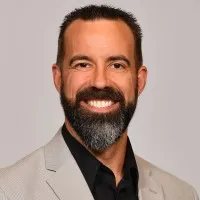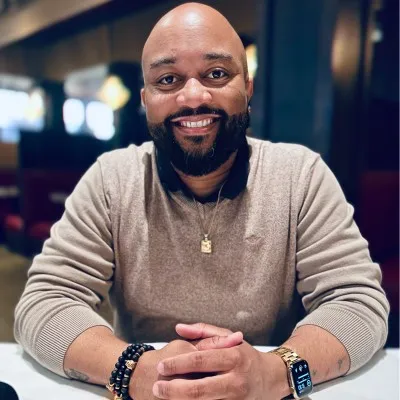Here are his lessons learned from organizations trying to apply PLG to their go-to-market motion, and how to make it actionable for PreSales professionals.
Why Product-Led Growth Exists
The rise of PLG comes down to the way that buyers are buying. In the B2B world now, you have people like Paul who have learned to buy things on their phone, or to buy an app and play around with it. They want to be independent, and are impatient with hand-holding.
And most of the decisions that are going to be made about buying a product are made outside of sales calls. 50% of buyers say the demo for your product is the decision maker in the process. 43% of buyers prefer a buying experience without a sales rep, and this number is even higher for younger generations.
What PLG Means for PreSales
There are pros and cons to product-led growth for the PreSales profession.
One of the biggest pros is that when you implement a PLG approach, the buyers are more informed. You’re not talking to people who are just discovering your product, so you get to do fewer boring overviews.
And this trend ties in with the rise of the PreSales profession becoming more important because buyers crave interaction with people who know the product deeply. It also means we spend less time figuring out how to explain how a product works at its core. Buyers know the basics because they've been able to play with it already.
But there are cons as well to having more informed buyers. It’s the Dunning-Kruger Effect at work - people with only a little knowledge often believe they’re more expert than the experts. Sometimes you’ll get into a situation with a prospect who thinks they know more about the product than you do, even though you practically live in it. A good example is Liz from Slack in a previous PSLC discussion - she was struggling to get people to get a demo of the feature she was trying to show because they said, we know how to use Slack. But it was a different enterprise feature most people aren’t familiar with, and they would benefit from a demo.
Also with PLG, you have less control over how people experience your product. Whatever sentiment they get from using your product in their first impression is going to be hard to shake. Moving them away from that sentiment requires more work, and you can end up in a rabbit hole where the prospect implements something wrong and you need to make changes. In PreSales, we need to find a way to position ourselves to react to that problem.
The Elephant in the Room
Not everyone can do PLG - most companies were not set up for it, especially enterprise ones. But the challenge is not just about creating a free trial. It’s about the fact that the product you design to solve your customers’ problems is not the same as the product you’d design to sell it. This is why you see a lot of dropout and low conversion when companies just put a free trial on their website.
Instead, your PLG approach needs to be a thoughtful exercise in driving users to your product. The more complex your product is, the more precise you need to be in how you drive those users, and tie in your approach to your customer journey.
Paul’s advice concentrated on the PreSales approach to PLG, naturally. The best way to do it is to think of it from the buyer’s perspective. When you consider paying for software, the first thing you probably do is read or watch something about it - these are narrated experiences (e.g. video tours on your website). Then you get into a guided product overview - interacting with the product itself in a very controlled way in 3-5 clicks. From there, the buyer should have a high-level idea of what’s important.
Next, you look at the product according to features or persona - self-serve demos to highlight something specific. Then you get into something more customized to the end user or vertical. This stage is where SEs come in and create assets and also where it makes sense to have a free trial - after prospects have seen what it looks like and are invested. Finally, you get into the product purchase and the lifecycle stages after that, which are past the PreSales area of interest.
Qualities of a Full-Funnel PLG Champion
If you want to find the person who is going to be the PLG champion in your organization, and drive it to full-funnel use, you look for someone who will:
- Understand the product story
- Be a demo expert
- Design and maintain reusable assets
- Understand where customization matters
- Practice cross-functional collaboration every day
- Can pick up product conversations without backup
Hello, that’s PreSales! So we’re a key part of defining your organization’s PLG strategy. With our blend of technical knowledge and experience with customers, we’re well positioned to help move our organizations into full-funnel product-led growth. And it can help free up time for our SEs to do more high-value tasks, if your PLG motion is created thoughtfully with PreSales input.
Actionable Tips for Leaders
- Your SEs now more than ever must be product experts. You must invest in ensuring they know everything that works and doesn’t work - if not, you’re going to lose in the marketplace. And to some extent, a good SE team should be more in tune with the limits of the product than the product team (Paul notes this is a controversial but successful idea).
- Have your SEs focused on stage three of your sales funnel. They should not be introduced in the first stages of disco/demo - leave that to the sales team. Focusing on PreSales coming in when buyers have qualified themselves gets better results for the organization and lets SEs do work they love - solving interesting problems.
- Ensure SEs are deeply involved with marketing. This isn’t traditionally how it’s done, but working with the product marketing team so self-serve assets have the right messaging and product messaging is important. Otherwise, marketing teams can come up with messaging that is too high level and ineffective. Messaging needs to be tailored to be very relevant for your product users.
- Expand your demo usage. This means having a bunch of different solutions, making sure we understand how people are using our demos, and using that information to address 60% of the sales cycle that occurs outside of sales calls. This can mean sending people sending alerts or drip campaigns based on how you observe them using your demos, for example.
- Do things you’ve never done before. In this new space of demo creation and PLG, we have access we’ve never had before, and we as leaders should take advantage of that to run experiments. Try demoing future features, letting SDRs run demos, A/B message testing, etc. Don’t be afraid to try anything in the move to PLG to determine what works - it’s different for every organization.
Here are his lessons learned from organizations trying to apply PLG to their go-to-market motion, and how to make it actionable for PreSales professionals.
Why Product-Led Growth Exists
The rise of PLG comes down to the way that buyers are buying. In the B2B world now, you have people like Paul who have learned to buy things on their phone, or to buy an app and play around with it. They want to be independent, and are impatient with hand-holding.
And most of the decisions that are going to be made about buying a product are made outside of sales calls. 50% of buyers say the demo for your product is the decision maker in the process. 43% of buyers prefer a buying experience without a sales rep, and this number is even higher for younger generations.
What PLG Means for PreSales
There are pros and cons to product-led growth for the PreSales profession.
One of the biggest pros is that when you implement a PLG approach, the buyers are more informed. You’re not talking to people who are just discovering your product, so you get to do fewer boring overviews.
And this trend ties in with the rise of the PreSales profession becoming more important because buyers crave interaction with people who know the product deeply. It also means we spend less time figuring out how to explain how a product works at its core. Buyers know the basics because they've been able to play with it already.
But there are cons as well to having more informed buyers. It’s the Dunning-Kruger Effect at work - people with only a little knowledge often believe they’re more expert than the experts. Sometimes you’ll get into a situation with a prospect who thinks they know more about the product than you do, even though you practically live in it. A good example is Liz from Slack in a previous PSLC discussion - she was struggling to get people to get a demo of the feature she was trying to show because they said, we know how to use Slack. But it was a different enterprise feature most people aren’t familiar with, and they would benefit from a demo.
Also with PLG, you have less control over how people experience your product. Whatever sentiment they get from using your product in their first impression is going to be hard to shake. Moving them away from that sentiment requires more work, and you can end up in a rabbit hole where the prospect implements something wrong and you need to make changes. In PreSales, we need to find a way to position ourselves to react to that problem.
The Elephant in the Room
Not everyone can do PLG - most companies were not set up for it, especially enterprise ones. But the challenge is not just about creating a free trial. It’s about the fact that the product you design to solve your customers’ problems is not the same as the product you’d design to sell it. This is why you see a lot of dropout and low conversion when companies just put a free trial on their website.
Instead, your PLG approach needs to be a thoughtful exercise in driving users to your product. The more complex your product is, the more precise you need to be in how you drive those users, and tie in your approach to your customer journey.
Paul’s advice concentrated on the PreSales approach to PLG, naturally. The best way to do it is to think of it from the buyer’s perspective. When you consider paying for software, the first thing you probably do is read or watch something about it - these are narrated experiences (e.g. video tours on your website). Then you get into a guided product overview - interacting with the product itself in a very controlled way in 3-5 clicks. From there, the buyer should have a high-level idea of what’s important.
Next, you look at the product according to features or persona - self-serve demos to highlight something specific. Then you get into something more customized to the end user or vertical. This stage is where SEs come in and create assets and also where it makes sense to have a free trial - after prospects have seen what it looks like and are invested. Finally, you get into the product purchase and the lifecycle stages after that, which are past the PreSales area of interest.
Qualities of a Full-Funnel PLG Champion
If you want to find the person who is going to be the PLG champion in your organization, and drive it to full-funnel use, you look for someone who will:
- Understand the product story
- Be a demo expert
- Design and maintain reusable assets
- Understand where customization matters
- Practice cross-functional collaboration every day
- Can pick up product conversations without backup
Hello, that’s PreSales! So we’re a key part of defining your organization’s PLG strategy. With our blend of technical knowledge and experience with customers, we’re well positioned to help move our organizations into full-funnel product-led growth. And it can help free up time for our SEs to do more high-value tasks, if your PLG motion is created thoughtfully with PreSales input.
Actionable Tips for Leaders
- Your SEs now more than ever must be product experts. You must invest in ensuring they know everything that works and doesn’t work - if not, you’re going to lose in the marketplace. And to some extent, a good SE team should be more in tune with the limits of the product than the product team (Paul notes this is a controversial but successful idea).
- Have your SEs focused on stage three of your sales funnel. They should not be introduced in the first stages of disco/demo - leave that to the sales team. Focusing on PreSales coming in when buyers have qualified themselves gets better results for the organization and lets SEs do work they love - solving interesting problems.
- Ensure SEs are deeply involved with marketing. This isn’t traditionally how it’s done, but working with the product marketing team so self-serve assets have the right messaging and product messaging is important. Otherwise, marketing teams can come up with messaging that is too high level and ineffective. Messaging needs to be tailored to be very relevant for your product users.
- Expand your demo usage. This means having a bunch of different solutions, making sure we understand how people are using our demos, and using that information to address 60% of the sales cycle that occurs outside of sales calls. This can mean sending people sending alerts or drip campaigns based on how you observe them using your demos, for example.
- Do things you’ve never done before. In this new space of demo creation and PLG, we have access we’ve never had before, and we as leaders should take advantage of that to run experiments. Try demoing future features, letting SDRs run demos, A/B message testing, etc. Don’t be afraid to try anything in the move to PLG to determine what works - it’s different for every organization.
Here are his lessons learned from organizations trying to apply PLG to their go-to-market motion, and how to make it actionable for PreSales professionals.
Why Product-Led Growth Exists
The rise of PLG comes down to the way that buyers are buying. In the B2B world now, you have people like Paul who have learned to buy things on their phone, or to buy an app and play around with it. They want to be independent, and are impatient with hand-holding.
And most of the decisions that are going to be made about buying a product are made outside of sales calls. 50% of buyers say the demo for your product is the decision maker in the process. 43% of buyers prefer a buying experience without a sales rep, and this number is even higher for younger generations.
What PLG Means for PreSales
There are pros and cons to product-led growth for the PreSales profession.
One of the biggest pros is that when you implement a PLG approach, the buyers are more informed. You’re not talking to people who are just discovering your product, so you get to do fewer boring overviews.
And this trend ties in with the rise of the PreSales profession becoming more important because buyers crave interaction with people who know the product deeply. It also means we spend less time figuring out how to explain how a product works at its core. Buyers know the basics because they've been able to play with it already.
But there are cons as well to having more informed buyers. It’s the Dunning-Kruger Effect at work - people with only a little knowledge often believe they’re more expert than the experts. Sometimes you’ll get into a situation with a prospect who thinks they know more about the product than you do, even though you practically live in it. A good example is Liz from Slack in a previous PSLC discussion - she was struggling to get people to get a demo of the feature she was trying to show because they said, we know how to use Slack. But it was a different enterprise feature most people aren’t familiar with, and they would benefit from a demo.
Also with PLG, you have less control over how people experience your product. Whatever sentiment they get from using your product in their first impression is going to be hard to shake. Moving them away from that sentiment requires more work, and you can end up in a rabbit hole where the prospect implements something wrong and you need to make changes. In PreSales, we need to find a way to position ourselves to react to that problem.
The Elephant in the Room
Not everyone can do PLG - most companies were not set up for it, especially enterprise ones. But the challenge is not just about creating a free trial. It’s about the fact that the product you design to solve your customers’ problems is not the same as the product you’d design to sell it. This is why you see a lot of dropout and low conversion when companies just put a free trial on their website.
Instead, your PLG approach needs to be a thoughtful exercise in driving users to your product. The more complex your product is, the more precise you need to be in how you drive those users, and tie in your approach to your customer journey.
Paul’s advice concentrated on the PreSales approach to PLG, naturally. The best way to do it is to think of it from the buyer’s perspective. When you consider paying for software, the first thing you probably do is read or watch something about it - these are narrated experiences (e.g. video tours on your website). Then you get into a guided product overview - interacting with the product itself in a very controlled way in 3-5 clicks. From there, the buyer should have a high-level idea of what’s important.
Next, you look at the product according to features or persona - self-serve demos to highlight something specific. Then you get into something more customized to the end user or vertical. This stage is where SEs come in and create assets and also where it makes sense to have a free trial - after prospects have seen what it looks like and are invested. Finally, you get into the product purchase and the lifecycle stages after that, which are past the PreSales area of interest.
Qualities of a Full-Funnel PLG Champion
If you want to find the person who is going to be the PLG champion in your organization, and drive it to full-funnel use, you look for someone who will:
- Understand the product story
- Be a demo expert
- Design and maintain reusable assets
- Understand where customization matters
- Practice cross-functional collaboration every day
- Can pick up product conversations without backup
Hello, that’s PreSales! So we’re a key part of defining your organization’s PLG strategy. With our blend of technical knowledge and experience with customers, we’re well positioned to help move our organizations into full-funnel product-led growth. And it can help free up time for our SEs to do more high-value tasks, if your PLG motion is created thoughtfully with PreSales input.
Actionable Tips for Leaders
- Your SEs now more than ever must be product experts. You must invest in ensuring they know everything that works and doesn’t work - if not, you’re going to lose in the marketplace. And to some extent, a good SE team should be more in tune with the limits of the product than the product team (Paul notes this is a controversial but successful idea).
- Have your SEs focused on stage three of your sales funnel. They should not be introduced in the first stages of disco/demo - leave that to the sales team. Focusing on PreSales coming in when buyers have qualified themselves gets better results for the organization and lets SEs do work they love - solving interesting problems.
- Ensure SEs are deeply involved with marketing. This isn’t traditionally how it’s done, but working with the product marketing team so self-serve assets have the right messaging and product messaging is important. Otherwise, marketing teams can come up with messaging that is too high level and ineffective. Messaging needs to be tailored to be very relevant for your product users.
- Expand your demo usage. This means having a bunch of different solutions, making sure we understand how people are using our demos, and using that information to address 60% of the sales cycle that occurs outside of sales calls. This can mean sending people sending alerts or drip campaigns based on how you observe them using your demos, for example.
- Do things you’ve never done before. In this new space of demo creation and PLG, we have access we’ve never had before, and we as leaders should take advantage of that to run experiments. Try demoing future features, letting SDRs run demos, A/B message testing, etc. Don’t be afraid to try anything in the move to PLG to determine what works - it’s different for every organization.






.webp)


